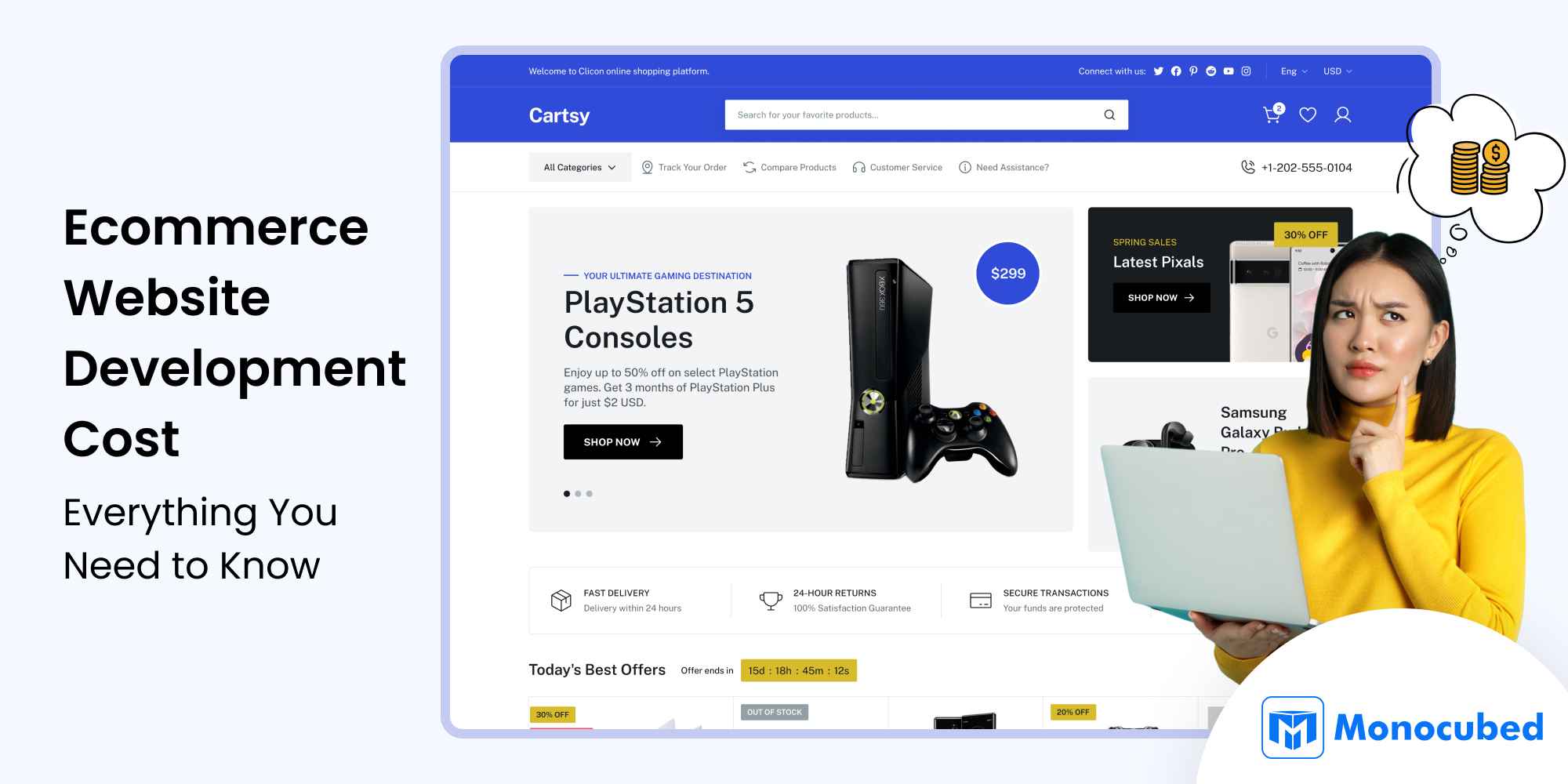Planning to start an ecommerce store but confused about the cost for ecommerce website development?
Getting quotes from $5,000 to $200,000 and don’t know which one is right for your business?
You’re not alone. Most entrepreneurs face the same challenge when trying to determine the cost of building an ecommerce website.
To help you understand the complete picture of ecommerce website development costs, we’ve created this comprehensive guide. From average pricing for different types of stores to the key factors that affect your final budget, you’ll find everything you need to make wise decisions.
By the end of this article, you’re going to learn how to:
- Understand the average cost of an ecommerce website based on store size and complexity
- Identify the key factors that affect ecommerce website development costs
- Compare platform-based vs. custom ecommerce development to plan your budget wisely
- Discover hidden and ongoing expenses to avoid surprises
- Choose the right development partner to get the best value for your investment
And suppose you’re planning something advanced, such as a multi-vendor marketplace or a custom B2B platform. You might also be interested in our ecommerce website development services, where we specialize in building solutions for complex business needs.
With a clear understanding of what to expect from this guide, let’s break down the costs. Let’s understand how much you can expect to invest in an ecommerce website, from small stores to enterprise marketplaces.
Table of Contents
- How Much Does Ecommerce Website Development Cost?
- 6 Key Factors That Impact Ecommerce Website Development Cost
- Cost of Creating a Replica of Popular eCommerce Websites
- Platform vs. Custom Development: Which is a Cost-Effective Option?
- Technology Stack Choices and Cost Implications
- Hidden Costs Often Overlooked in Ecommerce Development
- Ongoing Maintenance and Support Costs
- 5 Cost Optimization Strategies for Ecommerce Development
- How to Choose the Right Ecommerce Development Partner
- Partner with a Trusted Ecommerce Website Development Agency
- Frequently Asked Questions
How Much Does Ecommerce Website Development Cost?
The average cost of an e-commerce website ranges from under $5,000 for a DIY website builder to over $50,000 for a fully custom, enterprise-grade solution, with additional monthly expenses for hosting, themes, plugins, and maintenance depending on your setup and scale.
Generally, the price of an ecommerce website development depends on your store size, the features you need, and the development approach you choose.
Let’s break it down into simple categories to help you understand where your store fits:
- Small stores with basic features are budget-friendly options
- Medium stores with advanced functionality need moderate investment
- Large stores with complex features and high traffic capacity require significant budgets
- Enterprise marketplaces with custom everything cost the most
We’ll explain each category in detail. But first, let’s see how much each type costs.
| Store Size | Approx Cost | Features | Examples |
|---|---|---|---|
| Small Store (1-100 products) | $5,000 – $25,000 |
|
|
| Medium Store (100-500 products) | $25,000 – $75,000 |
|
|
| Large Store (500-2,000 products) | $75,000 – $200,000 |
|
|
| Enterprise Marketplace (2,000+ products) | $200,000 – $500,000+ |
|
|
Want to Know Your Ecommerce Development Cost?
Every business is different. Discuss your store idea with us and receive a personalized estimate for the cost of an ecommerce website tailored to your business needs and revenue goals.
Now that you know the general cost ranges, let’s dive deeper into what actually drives these costs. Understanding these factors will help you make smarter decisions about where to invest your budget.
6 Key Factors That Impact Ecommerce Website Development Cost
Before determining the accurate cost of an ecommerce website, it’s essential to understand the various factors that influence the overall cost.
Here are the 6 key factors that help you determine how much an ecommerce website costs.
-
Platform choice and licensing fees
Your platform choice is one of the most significant decisions that affects cost.
Here are the most popular ecommerce platforms and what they cost:
Platform Monthly Cost Transaction Fees Best For Shopify $5 – $399/month 2.4% – 3.9% + $0.30 Small to medium businesses, quick launch, ease of use WooCommerce $49 – $299 (hosting + plugins) Payment gateway fees only WordPress users have complete control and customization flexibility BigCommerce $29 – $399/month Payment gateway fees only Growing stores, no transaction fees, B2B features Magento $100 – $500 (hosting + maintenance) Payment gateway fees only Medium to large stores, complex requirements, scalability Shopify Plus $2,300 – $2,500+/month $0.20 High-volume brands, enterprise features, dedicated support Wix eCommerce $29 – $159/month $0.30 Very small stores, beginners, all-in-one simplicity According to eMarketer, global ecommerce sales are projected to reach $6.86 trillion by 2025. This massive growth means choosing the right platform isn’t just about cost; it’s about positioning your business to capture market share.
Your platform lays the foundation, but what customers actually see and experience is your design. Let’s examine how design choices affect your budget.
-
Design complexity and customization
How your store looks and feels directly impacts ecommerce website design costs.
Let’s talk about the three main design approaches to estimate the ecommerce website design price:Design Approach Cost Range What You Get Best For Template-based $1,000 – $5,000 Pre-made theme with basic customization (colors, logos, fonts) Testing business ideas, tight budgets, quick launch Semi-custom $5,000 – $25,000 Template foundation with significant customization (unique layouts, custom sections, branding) Established brands wanting distinction without full custom cost Fully custom $25,000 – $100,000+ Everything designed from scratch (unique layouts, animations, interactions, branded experience) Premium brands, unique requirements, competitive differentiation Research shows that 94% of first impressions relate to design according to the CXL stats report. So while custom design costs more upfront, it can significantly improve conversion rates and customer trust.
While design determines how your store looks, features determine what it can actually do. And this is where costs can really add up or where you can save by being strategic about what you truly need.
-
Feature set and functionality
The features you add to your store have the biggest impact on total cost. Every feature requires development time, testing, and maintenance.
Basic ecommerce features (included in most platforms):
- Product catalog with categories
- Shopping cart
- Checkout process
- Payment gateway
- Order management
- Customer accounts
- Email notifications
These basics are standard. The cost increases when you add advanced features.
Advanced features:
Feature Category Cost Range Examples Search & Discovery $3,000 – $8,000 Advanced search with filters, autocomplete, product sorting Personalization $5,000 – $15,000 AI product recommendations, personalized content, browsing history Customer Engagement $3,000 – $10,000 Reviews and ratings, wishlist, Q&A, social proof Multi-currency/Language $4,000 – $12,000 Currency conversion, language translation, regional pricing Inventory Management $5,000 – $20,000 Real-time tracking, low stock alerts, warehouse integration Shipping $3,000 – $10,000 Real-time rates, multiple carriers, tracking integration Complex functionality:
Feature Type Cost Range Use Case Multi-vendor Marketplace $30,000 – $100,000+ Allow others to sell on your platform Subscription/Recurring Billing $15,000 – $50,000 Membership sites, subscription boxes Custom Product Configurators $10,000 – $40,000 Build-your-own product, customization options B2B Wholesale Pricing $20,000 – $80,000 Tiered pricing, approval workflows, net terms Advanced Loyalty Programs $8,000 – $30,000 Points, rewards, VIP tiers, referrals AR/VR Product Visualization $15,000 – $60,000 Virtual try-on, 3D product views Mobile App Development $30,000 – $150,000 Native iOS and Android apps For example, if you want to build a food delivery app, the basic features would include displaying restaurants and allowing users to place orders. However, to make your app competitive, you need advanced features such as real-time tracking, multiple payment options, restaurant filters, and ratings.
Each additional feature increases the cost. However, they also enhance your store’s appearance.
Of course, your ecommerce store won’t operate in isolation. It needs to connect with other tools and services to function efficiently. Let’s look at integration costs.
-
Third-party integrations
Modern ecommerce stores don’t work alone. They connect with other tools and services.
When planning your project, how much an ecommerce website costs can depend heavily on the complexity and number of integrations required:
Integration Type Cost Range Examples Basic integrations $500 – $2,000 each Email marketing (Mailchimp, Klaviyo), Analytics (Google Analytics), Social media pixels Intermediate integrations $2,000 – $8,000 each Shipping providers (FedEx, UPS, DHL), Payment gateways (Stripe, PayPal), CRM systems (Salesforce, HubSpot), SMS marketing platforms Complex integrations $8,000 – $30,000+ each ERP systems (SAP, Oracle), Custom inventory systems, Warehouse management (WMS), Point-of-sale (POS) systems Do you need to integrate third-party services? Talk to an ecommerce web development team to understand which integrations are essential now and which can wait. These decisions play a big role in determining the overall cost of setting up an ecommerce website, especially when balancing functionality with budget.
-
Security and compliance
According to a Visa report, 75% of data breaches investigated in early 2022 involved ecommerce companies. Investing in security protects both your business and your customers.
When planning your budget and considering how much does an ecommerce website costs, remember that robust security and compliance measures are essential and can impact overall e-commerce website development costs.
Security Component Cost Range Frequency SSL Certificate $10 – $200 Annual PCI DSS Compliance $1,000 – $70,000+ Annual Web Application Firewall (WAF) $500 – $3,000 Annual DDoS Protection $500 – $5,000 Annual Security Audits $2,000 – $15,000 Annual or quarterly Fraud Prevention Tools $100 – $1,000+ Monthly Note: These costs are estimates only; actual pricing depends on store complexity, customization, and vendor rates.
Beyond platform, design, features, integrations, and security, there’s one more major factor that can dramatically swing your costs: where your development team is located.
-
Development team location and expertise
Where your developers are located has a significant impact on hourly rates.
However, remember that the lowest price doesn’t always equate to the best value.
Here’s the ecommerce website development cost breakdown based on regions:
Location Hourly Rate North America $100 – $250/hour Western Europe $75 – $150/hour Eastern Europe $40 – $100/hour Latin America $30 – $75/hour Asia $20 – $60/hour Note: These costs are estimates only; actual pricing depends on store complexity, customization, and vendor rates.
Cost calculation example:
A medium-complexity ecommerce project requiring 500 development hours:
- North America team: $50,000 – $125,000
- Eastern Europe team: $20,000 – $50,000
- Asia team: $10,000 – $30,000
Consider the total project cost, not just hourly rates. A team charging $150/hour that works efficiently might cost less than a $30/hour team that needs more time and revisions.
Once you’ve factored in location, expertise, and efficiency, the next major cost influencer is your ecommerce site development approach.
Have an Ecommerce Idea? Confused Where to Start?
Get free validation for your idea, expert advice, and a transparent cost estimate. Talk to our ecommerce development team.
Cost of Creating a Replica of Popular eCommerce Websites
To understand the potential investment required for building an eCommerce platform, it helps to look at approximate costs associated with well-known eCommerce websites. These estimates provide a ballpark figure, but actual costs can vary based on several critical factors, including store size, features, functionality, popularity, and robustness.
Below is a comparison of some popular eCommerce platforms with estimated development costs and timelines:
| Popular eCommerce Store | Estimated Development Cost |
|---|---|
| Amazon | $50,000 – $150,000 |
| eBay | $50,000 – $100,000 |
| AliExpress | $50,000 – $90,000 |
| Target | $40,000 – $100,000 |
| Walmart | $50,000 – $100,000 |
| Alibaba.com | $50,000 – $100,000 |
| Rakuten | $40,000 – $80,000 |
| JD.com | $30,000 – $70,000 |
Note: These costs are estimates only; actual pricing depends on store complexity, customization, and vendor rates.
Platform vs. Custom Development: Which is a Cost-Effective Option?
This is one of the biggest questions when planning your ecommerce budget. The platform vs custom decision significantly affects both your upfront investment and long-term ecommerce website costs.
| Aspect | Platform-Based (Shopify, WooCommerce, BigCommerce) | Custom Development |
|---|---|---|
| Best For | Small to mid-sized businesses with simple products and workflows | Complex or large-scale businesses with unique requirements |
| Initial Investment | $5,000 – $30,000 | $50,000 – $500,000+ |
| Timeline | 4 – 12 weeks | 4 – 18 months |
| Technical Requirement | Minimal; no in-house tech team needed | Requires experienced dev team and project management |
| Maintenance | Managed by platform; regular updates included | Fully custom; ongoing maintenance by developers |
| Scalability | Moderate; limited by platform rules | Highly scalable; full control over functionality |
| Customization | Limited to available plugins and APIs | Fully flexible; build anything needed |
| Long-Term Costs (5 Years) | ~$200K (including subscriptions + fees) | ~$280K (including hosting + maintenance) |
| Transaction Fees | 0.5% – 2% per sale | None |
| Performance & Control | Dependent on platform infrastructure | Full control, better optimization |
| Ideal For | Quick launch under $30K budget | Businesses scaling beyond $5M+ in sales |
Note: These costs are estimates only; actual ecommerce website development pricing depends on store complexity, customization, and vendor rates.
Choosing between platform-based and custom ecommerce website development is a critical decision that impacts your budget and future growth. At Monocubed, we’ve helped hundreds of businesses make this choice based on their unique needs and goals.
Not sure which approach is right for your business? Talk to our web development experts and get honest recommendations based on your requirements and budget.
Technology Stack Choices and Cost Implications
Choosing the right technology stack is critical when building an eCommerce website. It impacts both initial development costs and long-term maintenance, while determining your store’s performance, scalability, and user experience.
| Technology | Type | Estimated Cost |
|---|---|---|
| React.js / Next.js | Frontend | $50 – $150/hr |
| HTML/CSS/JavaScript | Frontend | $30 – $80/hr |
| Node.js / Express | Backend | $50 – $120/hr |
| PHP / Laravel | Backend | $40 – $100/hr |
| Python / Django | Backend | $50 – $130/hr |
| Cloud Hosting (AWS, Google Cloud, Azure) | Hosting | $50 – $5,000+/mo |
| Databases (MySQL, PostgreSQL, MongoDB, Redis) | Storage | Free – $300/mo |
Note: These costs are estimates only; actual pricing depends on the complexity of the store, customization requirements, and vendor rates.
The right technology stack depends on your specific needs, not just what’s cheapest. Sometimes, paying more up front saves money in the long term. However, when analyzing ecommerce website pricing, it’s essential to look beyond the visible development and technology costs.
Several hidden expenses, such as integrations, third-party tools, and post-launch maintenance, can often add 20–40% to your total budget if not planned for.
Hidden Costs Often Overlooked in Ecommerce Development
Many businesses forget to budget for these essential expenses:
- Content creation: Professional product photography ($50-$500 per product) and copywriting ($50-$200 per product) can cost for your initial catalog.
- Data migration: Moving products, customers, and orders from old systems typically costs between $2,000 and $20,000.
- Testing and QA: Comprehensive testing across browsers, devices, and payment systems runs $5,000-$25,000.
- Training: Staff training on your new platform costs $2,000-$10,000.
- Launch essentials: Domain setup, SSL certificates, email configuration, and initial marketing typically add $5,000-$50,000.
Beyond the initial development and launch costs, running an ecommerce store involves ongoing expenses that continue month after month and year after year. Understanding these recurring ecommerce website costs is crucial for accurate financial planning and profitability calculations.
Ongoing Maintenance and Support Costs
After launching your store, expect ongoing costs that keep it running smoothly and secure.
What’s included in ongoing costs:
- Platform subscription or ecommerce website hosting fees
- Security updates and SSL certificates
- Software updates and bug fixes
- Performance optimization
- Payment processing fees (2.9% + $0.30 per transaction)
- Apps and plugins
- Technical support
- New features and improvements
Total ongoing costs:
- Platform-based stores: $500 – $5,000+ per month
- Custom-built stores: $1,000 – $10,000+ per month
Annual maintenance rule: Budget 15-20% of your initial development cost annually for maintenance and improvements. For example, a $50,000 website typically needs $7,500-$10,000 per year in ongoing maintenance.
Thoughtful planning includes setting aside 10-15% of annual revenue for continuous improvements. This keeps your store competitive and growing with customer expectations.
5 Cost Optimization Strategies for Ecommerce Development
Want to save money without compromising the quality of your store? Here’s how.
- Start with an MVP (Minimum Viable Product). Launch with only essential features—product catalog, cart, checkout, and payment processing. Add advanced features later based on actual customer feedback and sales data. This approach reduces initial investment by 30-50%.
- Choose the right platform for your current size. Don’t over-engineer. A $5,000 Shopify store might be perfect for testing your market before investing $100,000 in custom development.
- Use third-party integrations instead of building everything. Why spend $50,000 building a payment system when Stripe costs $3,000 to integrate? Leverage existing solutions for shipping, email marketing, and analytics.
- Hire strategically based on location. Eastern European developers offer high quality at $40-$100/hour versus $150-$250/hour in North America. You could save $50,000+ on the same project.
- Invest in scalable architecture from the start. Spending 10-15% more upfront on proper architecture saves you from expensive rebuilds later.
Now that you understand all the cost factors, from initial development to ongoing expenses, the next critical decision is choosing who will build your store. The right development partner can save you thousands and prevent costly mistakes, while the wrong choice can lead to budget overruns and a platform that doesn’t meet your needs.
How to Choose the Right Ecommerce Development Partner
Picking the right team to build your store is crucial. The right partner saves you money and delivers on time. The wrong one? You’ll face budget overruns, missed deadlines, and a platform that doesn’t work.
So how do you choose the right ecommerce development partner?
-
Check their platform expertise
Do they specialize in the platform you want to use?
If you’re building on Shopify, look for certified Shopify Partners. Going with WooCommerce? Find a team with strong WordPress experience.
Ask to see at least 5 projects similar to yours. Not just any projects—ones that match your industry and store size.
Why does industry matter? Because a fashion store needs different features than a B2B industrial supplier. Healthcare ecommerce has strict compliance requirements. Your developer should understand your specific challenges.
-
Look at their portfolio
Don’t just trust what they tell you. See what they’ve actually built.
Visit their live websites. Click around. Test on mobile. Check how fast they load.
Ask yourself:
- Are these designs modern or outdated?
- Do they look like templates or custom work?
- Are the sites still being maintained?
If you only see mockups or screenshots, that’s a red flag. You want to see real, working websites.
For example, at Monocubed, we’ve built ecommerce platforms like Moovtore—a modern online store, and Sayyar, a custom Dubai-based ecommerce marketplace. You can explore our complete portfolio to see live examples of ecommerce and web projects we’ve delivered across different industries
-
Understand their pricing
How do they charge? Fixed-price or hourly?
Most website development agencies offer three pricing models:- Fixed-price: You pay a set amount for a defined scope. Great for clear requirements. But changes cost extra.
- Time and materials: You pay for actual hours worked. More flexible but harder to predict final cost.
- Retainer: Monthly fee for ongoing work. Best for post-launch support.
Whatever model they use, get everything in writing
-
Ask about post-launch support
Here’s something most people forget: launching your store is just the beginning.
You’ll need help fixing bugs. Adding features. Updating security. Optimizing performance.
Ask them directly:
- What support do you offer after launch?
- How fast do you respond to urgent issues?
- Can I reach someone on weekends?
- What are your maintenance packages?
Support typically costs $500-$8,000/month depending on response time and what’s included.
Partner with a Trusted Ecommerce Website Development Agency
At Monocubed, we’ve helped businesses like yours build successful ecommerce stores.
From $10,000 startups launching their first product to established brands doing millions in sales, we understand what it takes at every stage.
What makes us different?
- Provide transparent pricing and upfront cost
- 50+ expenrts use moder practices and AI tools to launch websites faster.
- Technical expertise in Shopify, WooCommerce, Magento, React.js, Node.js, PHP Laravel, and more.
- AI-enhanced development of smart product recommendations, chatbots, and personalized shopping experiences.
- Build fast, secure ecommerce stores and ready to handle growing traffic and sales.
- We stay with you post-launch to optimize, add features, and grow your business.
Ready to Get a Transparent Ecommerce Development Cost Estimate?
Let’s discuss your specific requirements and give you an honest, detailed breakdown of what your ecommerce store will actually cost—no inflated quotes, no hidden fees.
Frequently Asked Questions
-
How long does ecommerce website development take?
It depends on complexity.
- Simple platform stores: 4-8 weeks.
- Medium complexity with customization: 2-4 months.
- Custom ecommerce platforms: 4-8 months. Enterprise marketplaces: 8-18 months.
Timeline depends on features, design complexity, integrations, and how quickly you provide feedback and approvals.
-
Should I use Shopify or custom ecommerce development?
Choose Shopify if you have under $30,000 budget, need quick launch (2-3 months), sell straightforward products, and want easy management.
Choose custom ecommerce development services if you have unique requirements, need complex integrations, want complete control, require advanced B2B features, or expect high traffic volume. For most small businesses starting out, Shopify offers the best balance.
-
What are the benefits of developing an ecommerce website?
Building a well-designed eCommerce website offers numerous advantages for businesses looking to sell products online effectively. Key benefits include:
- Wider reach: Connect with customers locally and globally.-
- 24/7 availability: Your store is always open, boosting sales opportunities.-
- Lower operational costs: Reduce overhead compared to physical stores.-
- Personalized shopping experience: Tailor recommendations and promotions for each user.-
- Efficient inventory management: Track and update stock in real time.-
- Flexible payment options: Offer multiple secure payment methods.-
- Enhanced Customer Support: Provide faster assistance and engagement.-
-
What are the key factors for ecommerce success?
Success in eCommerce depends on several crucial factors that drive sales, improve customer experience, and support long-term growth. These include:
- High-quality products and services
- A user-friendly, intuitive website
- Mobile responsiveness
- Secure and fast checkout
- 24/7 customer support
- Transparent pricing
- Multiple payment options
 By Yuvrajsinh Vaghela
By Yuvrajsinh Vaghela


